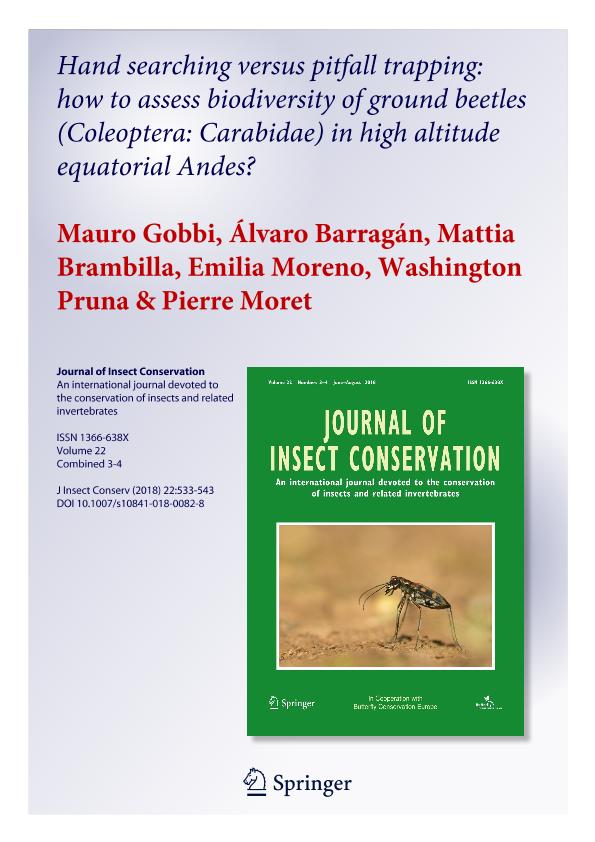Mostrar el registro sencillo del ítem
dc.contributor.author
Gobbi, Mauro Javier

dc.contributor.author
Barragán, Álvaro
dc.contributor.author
Brambilla, Mattia
dc.contributor.author
Moreno Coellar, Emilia

dc.contributor.author
Pruna, Washington
dc.contributor.author
Moret, Pierre
dc.date.available
2022-10-05T13:15:28Z
dc.date.issued
2018-08
dc.identifier.citation
Gobbi, Mauro Javier; Barragán, Álvaro; Brambilla, Mattia; Moreno Coellar, Emilia; Pruna, Washington; et al.; Hand searching versus pitfall trapping: how to assess biodiversity of ground beetles (Coleoptera: Carabidae) in high altitude equatorial Andes?; Springer; Journal of Insect Conservation; 22; 3-4; 8-2018; 533-543
dc.identifier.issn
1366-638X
dc.identifier.uri
http://hdl.handle.net/11336/171924
dc.description.abstract
The use of ground beetles (Coleoptera: Carabidae) as bioindicators of environmental change depends on the reliability and the effectiveness of the sampling methods. Those that have been tested in the temperate zone and in tropical forests still await experimentation in tropical high-altitude environments. For the first time, pitfall trapping and hand searching have been compared in Ecuadorian páramo above 4000 m a.s.l., in terms of practical effectiveness. The study was performed on six volcanoes and was based on the comparison of 28 sampling sessions (pitfall trapping and hand searching) performed along two different elevational belts [lower superpáramo (LSP) and upper superpáramo (USP)]. Analyses of sampling sessions showed that detected species richness is slightly higher with hand searching than with pitfall trapping, regardless of the elevation. Additionally, hand searching is more time-effective than pitfall trapping. The performance of the sampling method slightly varies when species assemblage composition is analysed in relation to elevational belts. In the LSP, hand searching and pitfall trapping should be simultaneously used to obtain exhaustive inventories of carabid biodiversity, since different species are likely to be collected by each method. In the USP, hand searching and pitfall trapping efficiency is very similar, but hand searching allows to collect a slightly larger number of species. Lastly, the sample-based rarefaction curves showed that four temporal replicates are mandatory to obtain a robust dataset and an exhaustive inventory of the true species richness and species assemblages composition. Our findings suggest a combined use of hand searching and pitfall trapping in the LSP, while both methods can be used alone for surveying carabids in the USP. Furthermore, hand searching is recommended if the aim is to obtain an inventory of species diversity, whereas pitfall trapping seems more convenient for fine grain ecological and comparative studies.
dc.format
application/pdf
dc.language.iso
eng
dc.publisher
Springer

dc.rights
info:eu-repo/semantics/openAccess
dc.rights.uri
https://creativecommons.org/licenses/by-nc-sa/2.5/ar/
dc.subject
ECUADOR
dc.subject
HARSH ENVIRONMENTS
dc.subject
PÁRAMO
dc.subject
SAMPLING EFFORT
dc.subject
SAMPLING METHODS
dc.subject
SPECIES RICHNESS
dc.subject.classification
Conservación de la Biodiversidad

dc.subject.classification
Ciencias Biológicas

dc.subject.classification
CIENCIAS NATURALES Y EXACTAS

dc.title
Hand searching versus pitfall trapping: how to assess biodiversity of ground beetles (Coleoptera: Carabidae) in high altitude equatorial Andes?
dc.type
info:eu-repo/semantics/article
dc.type
info:ar-repo/semantics/artículo
dc.type
info:eu-repo/semantics/publishedVersion
dc.date.updated
2022-04-20T14:48:53Z
dc.journal.volume
22
dc.journal.number
3-4
dc.journal.pagination
533-543
dc.journal.pais
Alemania

dc.description.fil
Fil: Gobbi, Mauro Javier. Museo delle Scienze; Italia
dc.description.fil
Fil: Barragán, Álvaro. Pontificia Universidad Católica del Ecuador; Ecuador
dc.description.fil
Fil: Brambilla, Mattia. Museo delle Scienze; Italia
dc.description.fil
Fil: Moreno Coellar, Emilia. Consejo Nacional de Investigaciones Científicas y Técnicas. Oficina de Coordinación Administrativa Ciudad Universitaria. Instituto de Fisiología, Biología Molecular y Neurociencias. Universidad de Buenos Aires. Facultad de Ciencias Exactas y Naturales. Instituto de Fisiología, Biología Molecular y Neurociencias; Argentina
dc.description.fil
Fil: Pruna, Washington. Pontificia Universidad Católica del Ecuador; Ecuador
dc.description.fil
Fil: Moret, Pierre. Université Paul Sabatier; Francia
dc.journal.title
Journal of Insect Conservation

dc.relation.alternativeid
info:eu-repo/semantics/altIdentifier/url/http://link.springer.com/10.1007/s10841-018-0082-8
dc.relation.alternativeid
info:eu-repo/semantics/altIdentifier/doi/http://dx.doi.org/10.1007/s10841-018-0082-8
Archivos asociados
